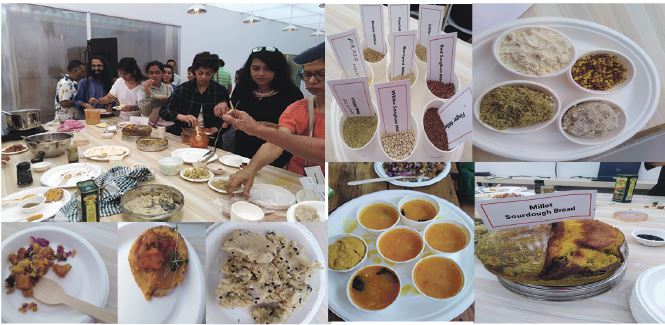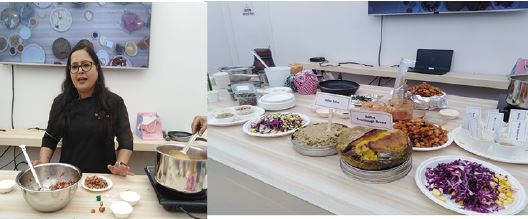PROMOTING MILLETS…at SAF’s daily Food Lab sessions. Here is millet couch Shalini Rajani all the way from Gurgaon conducting a hands-on workshop to revive the ancient millets for food security.
By Tara Narayan
LIKE it not, good in the long run or bad in the run, I do not know. The humble millet (say barnyard millet or pearl millet) I used to buy as a kid in village Gujarat, for “char anna” per “ser” or so from the local grocery outlet in the village market. Poor people’s food has now become rich people’s food for sure! It’s selling at Rs150 to Rs250 per half kg or 400 g today…I don’t know how many folk further down the line of the good life may now be able to afford to eat it.
Unless the government of the day ration shops, or government child and family welfare departments, supply organically grown wholesome millets to the economically backward people at very nominal prices! Will it happen with this government at least?
It’s almost like the well-to-do may eat protein-rich, fibre-rich, nutritious millets while the poor may eat the discarded cheap GMO wheat and all kinds of inferior rice which are now more affordable for them presumably! This is to say I do believe we can promote something to death and especially if it is coming from the topmost government policy-makers who are well-meaning enough in urging farmers ready to commit suicide to grow millets, and all their crop will be taken up by government agencies – at what price, your guess is as good as mine.
SO once again I realized how millets have gone upmarket and have now begun to turn up on five-star hotel menus. There are even millet coaches to teach you how to eat the dozen odd millets of India and the ancient world! I dropped in at the recent Serendipity Art Festival’s culinary session on how to eat millets conducted by the very learned millets coach Shalini Rajani. She is a big-time millets coach with her own company in Gurgaon if I remember right. Her dishes are certainly innovative and she demonstrated some of them in the workshop, namely farmyard millet pineapple millet, foxtail millet tacos with sweet potato topping…much relished by the audience when they got to taste them generously at the end of the session (the SAF culinary sessions were heavily booked up on payment of Rs99 and truly entertaining affairs). Alas, I’m sorry I missed most of them for reasons best known to me!
KNOW YOUR MILLETS
TO stay with the gente art of serving millets, however, coach Shalini certainly knows her millets and she bust a few common beliefs like quinoa is a millet, it is not. Amaranth is also not a millet, nor is buckwheat. We in India are familiar with “kodo” or “kodra” little millet, and “kangani” or foxtail millet, there is also the grey grey large millet of “bajra” or pearl millet…in some states like Maharashtra they like to eat “jowar” and “ragi” (nachne) millets; “bajra” is popular in Gujarat.
For her tacos she uses the large proso millet but you have to knead the flour properly. Her barnyard pineapple rasam served with sourdough croutons was delicious! The topping she put on the proso millet tacos were a little hard but the topping of sweet potato was very agreeable…she also does something exotic called cashew fritters.
Most of the ancient millets are ancient grains and find favour with farmers because they are drought-resistant, require little water and are nutritious; the tough-skinned ones do require longer soaking for better cooking and digestibility. Some millets make for lighter meals, some for more heavyweight meals – so we have to know our millets before cooking them in a recipe. The outer layer of some of the millets is tough because of “phytic acids” and that is why we have to soak them before using them.
Shalini says sprouted millet flours are the best. Most of us tend to buy the millets and straightaway run them through a flour mill to arrive at the flour! Try soaking them, sprouting them before flouring them and yes, “Don’t tell the kids it’s millets and they’ll love them!” Of course she combines all kinds of things while doing millets – veggie puree, chia jello, flax and sesame seeds, Italian seasoning, extra virgin olive oil…by the way we are mostly familiar with white sorghum (that is jowar) but look for red sorghum too. Jowar is good for tacos and hard crust “puri” – one may combine millet flour with chickpea flour to get one desires. Out in Gurgaon they have become very fond of “jack chips” (jackfruit) as a snack!
All these useful tips and much more, it was a most lively session. Proso millet, says Shalini, has the highest protein. Answering questions about her excellent sourdough bread (a large loaf of which was on display and the cynosure of all eyes) was made of millet and kapli wheat which is lighter on the gut. Anisha Walia next to me was busy taking notes for she has a Dreamland Café out in Arambol near Mandrem beach, “We do coffee, crepes, grilled paneer, smoothies, I hope to do some of these millet recipes too now. You’re welcomed to drop in!” I may, I replied, I haven’t been out to the northern beaches or any beach for a long time, except for Miramar beach which is very close to where I live in Panaji.
Millet Shalini Rajani has been fine-tuning the various millets available in India for about seven years or so now, she confided, by all means check her out on her podcasts, “I’ve got students in 48 countries now!” If you want to do something which is catching fire the world over, you might want to do your homework on millets. Millet cuisine has arrived on the smorgasbord of the good life, my dears!

WINTER TIME VEGGIES
ME, I think I’ll stick to my plain Gujarati “bajra-no-rotlo” laced with desi ghee and relished with “bhinda-ni-kadi” laced with lots of chopped green coriander, grated jaggery as a side dish, and “leeli lasun-ni-chutney” (greens spring garlic chutney)…a most yummylicious combo and so down to earth. Which reminds me the Gujarati winter time culinary festival of “ponk” and “oondhiyu” must have commenced in Surat and in some of Mumbai suburbs…both Maharashtrian and Gujarati natives wait for fresh arrivals of tender green wheat and sorghum (jowar) millet to be fixed up in assorted savoury and tangy “chaat” item numbers.
Also come the tubers …sweet potato white and magenta, and purple yam (“ratalu” is much relished), pink yam (“suran”), along with various kinds of field beans like “valor,” “surti papdi,” the tender green tur dal pea pods… “leeli tuver.”
I have had my fill of “oondhiyu” parties in Mumbai – health conscious and not so health-conscious! Ondhiyu is just a medley of winter-time veggies cooked in an earthern pot, laced with assorted greens, wood-pressed sesame or groundnut oil, to be eaten with various exciting flavour-enticers like green chutney, tamarind chutney, chopped green spring garlic, a few more item numbers of the good earth.
Go find the recipes in some of the late culinary hostess Tarla Dalal’s cookbooks on Google. Enjoy! Make a few resolutions of the New Year of 2024 kind…like re-discovering truth, freedom and health and its linkages to arrive at a new life on the path of renewals. Whatever that means!
